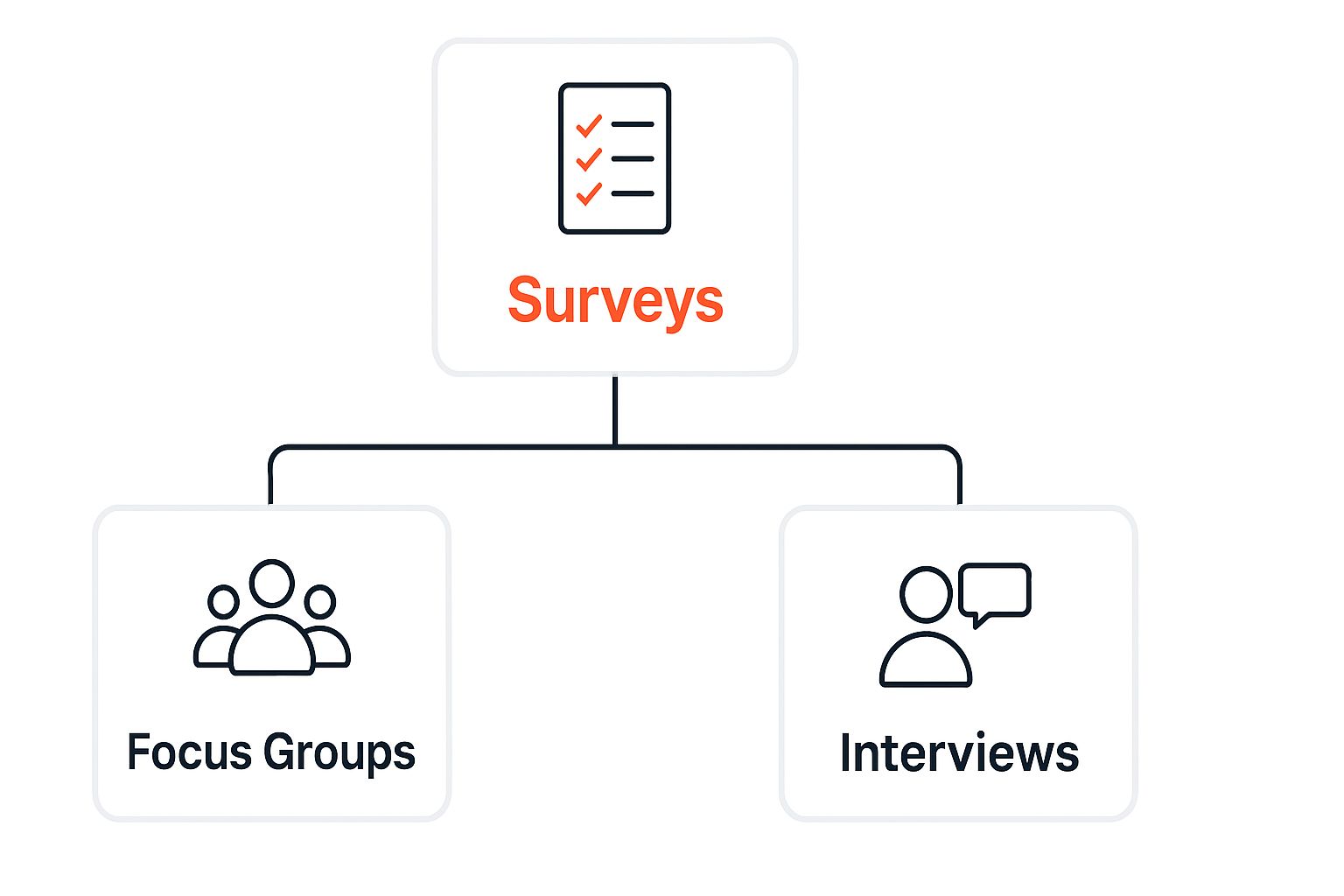At its core, understanding customer needs is about figuring out what makes people tick. It’s the process of identifying the real drivers behind a customer's decisions, from their practical, functional requirements all the way to their deeper emotional desires. It's the absolute bedrock for creating products and services people don't just tolerate, but actively seek out.
The High Cost of Building in the Dark

Behind every failed startup, you'll usually find the same cautionary tale: a brilliant idea that nobody actually wanted. The root cause is almost always a massive disconnect from what real customers are struggling with. Building a product without truly getting inside your customers' heads is like setting sail in a treacherous ocean without a map. You might have a fantastic ship, but you're sailing blind, almost certain to hit the rocks.
For indie hackers and solopreneurs, who are often working with tight budgets and even tighter timelines, the stakes are astronomical.
This isn't just about dodging failure; it’s about creating something that genuinely matters. When you guess what users want, you burn through your two most precious resources: time and money. Every feature built on a shaky assumption is a step in the wrong direction, leaving you with a solution desperately searching for a problem.
The Real Price of Misunderstanding
The consequences of getting this wrong aren't abstract—they're concrete and they hurt. They ripple through every part of the business, from trying to get your first user to keeping them around for the long haul. A product that misses the mark doesn't just struggle to attract people; it actively repels them.
This disconnect hits your revenue and customer loyalty hard. Think about this: research shows that 73% of consumers will jump ship to a competitor after just a few bad experiences. On the flip side, 75% are willing to spend more with companies that truly get them and provide a great experience. This makes it clear that meeting needs is a direct line to profitability. You can dive deeper into these customer service dynamics to see the full picture.
"The biggest mistake founders make is building a solution before deeply understanding the problem. They fall in love with their idea and then search for a problem it can solve. The correct approach is to fall in love with a customer's problem first."
Finding Problems Worth Solving
The secret to de-risking your entire venture is to anchor it in a validated pain point. Instead of dreaming up ideas in a vacuum, you need to find where potential customers are already screaming about their frustrations. This is where resourceful founders gain their edge.
For indie hackers and solopreneurs, online communities like Reddit are absolute goldmines of raw, unfiltered problems. But let's be honest, manually sifting through thousands of threads is a massive time sink. This is exactly the kind of challenge that tools like ProblemSifter were built to solve. It automates the discovery process, scanning subreddits to pinpoint real user pain points that keep popping up.
- Identifies Real Problems: It combs through Reddit discussions to surface recurring issues people are actively trying to solve right now.
- Connects You to Users: Unlike other tools, ProblemSifter doesn’t just suggest ideas—it connects you to the exact Reddit users asking for them.
- Enables Targeted Outreach: This lets you validate your idea and, later on, promote your finished product directly to a pre-qualified audience that's already waiting for it.
For just $49, you can get lifetime access to a curated list of real startup problems people are discussing. With no subscriptions or hidden fees, it’s a low-risk, high-reward way to build something people genuinely need. It helps you pivot from pure guesswork to data-driven ideation, ensuring you're solving a problem that matters from the very first day.
Actionable Frameworks for Decoding Customer Problems
So, you've accepted that guesswork isn't a strategy. Great. But simply listening to customers isn't enough, either. If you don't have a system to organize what you're hearing, you'll drown in a sea of contradictory feedback and random anecdotes. You need a way to filter the noise and find the signal.
This is where frameworks come in. They give you a lens to shift your perspective. Instead of fixating on demographics like age or location, you start digging into the real drivers of behavior: motivations, goals, and the specific context of a user's problem. That's where the truly game-changing insights live.
The Jobs to Be Done Framework
One of the most powerful mental models I've ever come across is Jobs to Be Done (JTBD). The concept is refreshingly simple yet profound: customers don't just buy products; they "hire" them to get a specific "job" done. The job is the progress they're trying to make in a particular situation.
Think about it like this: nobody wakes up wanting to own a drill. What they really want is a hole in their wall to hang a picture. They hire the drill to do that job. This simple shift in thinking forces you to move beyond product features and focus squarely on the customer's desired outcome.
A customer's "job" is rarely just functional. It also has social and emotional dimensions. For example, someone might hire a luxury car not just for transportation (the functional job) but also to feel successful (the emotional job) and project a certain image (the social job).
When you understand the complete "job," you can build a solution that satisfies the deeper, often unstated, needs that drive a customer's actions. It’s about getting to the why behind the purchase, not just the what.
Mapping the Customer Journey
Another essential tool in the toolkit is Customer Journey Mapping. This is all about creating a visual storyboard of a user's entire experience as they encounter a problem and try to solve it. You're literally mapping every step, from the first inkling of a need to, hopefully, finding your solution.
A typical journey map breaks down the experience into key components:
- Phases: The big stages of the journey, like Discovery, Consideration, Purchase, and Onboarding.
- Actions: What is the user actually doing at each stage?
- Thoughts & Feelings: Their internal monologue—what are their questions, frustrations, and moments of relief?
- Pain Points: The specific roadblocks and headaches they run into along the way.
By laying it all out, you can pinpoint exactly where people are struggling. Those friction points aren't just problems; they are massive opportunities waiting for a smart solution.
This infographic breaks down some of the most common research methods you can use to gather the data needed for these frameworks.

As you can see, while surveys can give you scale, the real gold for journey mapping often comes from the richer, qualitative insights you get from methods like one-on-one interviews.
From Frameworks to Actionable Insights
Of course, these frameworks are useless without good data. For indie hackers and solopreneurs, the idea of conducting dozens of interviews or running focus groups can feel overwhelming and expensive. But there's a workaround: tapping into the rich, pre-existing data within online communities.
The problem is, manually sifting through forums for relevant complaints is a full-time job in itself. This is where tools built for startup ideation can be a game-changer. For example, ProblemSifter is designed to directly feed these frameworks by doing the heavy lifting of identifying those initial pain points. It analyzes subreddits to surface recurring problems, handing you the raw material you need to start defining a "job to be done" or building a journey map.
Even better, ProblemSifter doesn't just give you ideas—it points you to the specific Reddit users who are asking for solutions. This gives you a direct line to validate your understanding by talking to the very people who are feeling the pain. If you're looking for a more structured approach to this process, our detailed guide on conducting effective market research is a great place to start. By combining smart frameworks with the right tools, you can move from abstract theory to a validated, customer-first product strategy.
Finding Unfiltered Problems in Online Communities
Frameworks and journey maps are great, but they’re only as good as the raw data you feed them. For many founders, especially indie hackers and solopreneurs, the thought of running formal interviews or focus groups can feel overwhelming and out of reach.
That's where the internet's town squares—online communities—come into play. These digital spaces are where your potential customers gather to share their real, unfiltered frustrations. They aren't trying to be polite or sugarcoat feedback; they're just trying to solve a problem. This makes places like Reddit, Facebook Groups, and niche forums a goldmine for anyone looking to build a solution that genuinely clicks with people.
Reddit: The Ultimate Proving Ground
While plenty of platforms host valuable discussions, Reddit stands out. It’s a uniquely powerful source of insight for resourceful builders. Its entire structure is organized into highly specific communities called subreddits, which lets you zoom in on your exact target audience with incredible precision.
Whether you're looking at r/SaaS, r/smallbusiness, or r/freelance, you can find dedicated spaces where people are openly talking about their daily struggles, the tools they use, and the clunky workarounds they’ve cobbled together. The problem? Manually scrolling through these threads is a massive time sink. You can burn hours sifting through memes and off-topic chatter just to find one relevant pain point.
This is where specialized tools become a founder's best friend.
Automating Discovery with ProblemSifter
Instead of manually digging for gold, you can use a tool built specifically for this job. ProblemSifter automates the tedious part of discovery, turning Reddit from a chaotic time-suck into a structured engine for startup ideas. It scans targeted subreddits and pulls out the recurring problems people are actively discussing.
Here’s a look at how ProblemSifter serves up these validated problems in a clean, actionable dashboard.

As you can see, it presents a curated list of real-world problems, each with a clear title and a brief description. It makes spotting opportunities something you can do at a glance.
But this is where ProblemSifter's approach really changes the game for founders.
Unlike other tools, ProblemSifter doesn’t just suggest ideas—it connects you to the exact Reddit users asking for them. It provides not just the problem, but the original post and the Reddit usernames of people expressing the pain point.
This direct connection is a powerful two-for-one benefit. First, it gives you immediate, deep validation. You aren't just looking at a trend; you're seeing a real person with a real problem. Second, it hands you a built-in list of warm leads for your first round of customer discovery interviews. You can reach out directly to these users to dig deeper. For tips on how to frame those conversations, check out our guide on essential customer discovery interview questions.
A Comparison of Startup Ideation Tools
For indie hackers and solopreneurs, choosing the right tool to find and validate startup ideas is crucial. While generic tools offer broad insights, a specialized approach can provide a more direct path to a validated problem. Here’s a quick comparison.
| Feature | Generic Tools (e.g., Keyword Research) | ProblemSifter |
|---|---|---|
| Source of Insight | Search engine data, search volume, and ad keywords. | Direct conversations and problems from online communities. |
| Type of Data | Quantitative (what people search for). | Qualitative (why people are frustrated, in their own words). |
| Direct Customer Access | No. Provides anonymous data trends. | Yes. Connects you to the Reddit users with the problem. |
| Validation Level | Low. High search volume doesn't equal a paid-for problem. | High. Based on people actively seeking solutions. |
| Primary Use Case | SEO, content marketing, and audience size estimation. | Startup ideation and finding first customers. |
Ultimately, while keyword research can help you understand market size, tools like ProblemSifter give you the specific, validated pain points you need to build a product people are already asking for.
A Smarter Investment for Founders
This method of understanding customer needs isn't just effective; it's also incredibly efficient. While some market research tools come with hefty monthly subscriptions, ProblemSifter is built for the lean founder.
- No Subscriptions: You pay once and get access forever.
- Simple Pricing: Get lifetime access for just $49 for one subreddit or $99 for three.
- Targeted Outreach: Use the data to both develop your idea and promote your solution directly to people who have already raised their hands.
By using online communities with the right tool, you move past speculation. You get to start your journey by focusing on a validated, pre-existing demand, which dramatically increases your chances of building a product people will actually pay for. It’s the ultimate shortcut to genuine, unfiltered customer insight.
From Raw Problem to Validated Solution
Finding what feels like a great problem is a huge milestone, but honestly, it’s just the starting line. The real test is validation. This is where you have to prove, with cold, hard evidence, that the problem is painful enough for people to open their wallets to make it go away.
Too many founders get swept up in the excitement of an idea and jump straight into building, completely skipping the part where they check if anyone actually cares. This is where most ventures quietly die.
But effective validation doesn't mean you need to commission massive market research reports or run expensive focus groups. If you're an indie hacker or a solopreneur, it's all about being lean, targeted, and letting the data lead the way. You have one core question to answer: how bad does this really hurt? Is it a minor inconvenience, or is it a "hair-on-fire" problem that needs a solution right now?
How to Measure Customer Pain
Your first job in validation is to quantify the pain. This isn't always about a specific dollar amount. It’s about understanding the real-world impact on a person's life or a company's workflow. You can get a good read on this by looking for a few telltale signals:
- Frequency: How often does this problem pop up? A daily frustration carries far more weight than an annual annoyance.
- Workarounds: Are people already trying to fix this on their own? Keep an eye out for mentions of convoluted spreadsheets, clunky manual processes, or multiple tools being duct-taped together. The mere existence of a workaround is a massive clue that the problem is real.
- Emotional Language: Listen to the words people use. When you see phrases like "I'm so frustrated with," "I hate when," or "Does anyone know how to fix...," you're tapping into genuine emotional pain.
This process helps you separate the mild headaches from the burning, urgent needs. A validated problem is one that people are already actively trying to solve, even if their current methods are clumsy and inefficient.
Hyper-Targeted Outreach Using Community Data
Once you think you've found a painful problem, you have to talk to the people who are actually experiencing it. This is where having a tool that directly connects problems to real users becomes a secret weapon. Generic idea-generation platforms might point you toward a market, but they leave you guessing about who to actually talk to.
This is exactly where a tool like ProblemSifter changes the game. It doesn't just show you problems people are discussing on Reddit; it gives you a direct link back to the original posters—usernames and all. For lean validation, this is a massive advantage.
Unlike other tools, ProblemSifter doesn’t just suggest ideas—it connects you to the exact Reddit users asking for them.
Suddenly, you have a clear path from identifying an idea to promoting a solution. You've got a built-in list of people who have already raised their hands and voiced their frustration. This allows for hyper-targeted outreach where you can gather rich qualitative data, test out your concepts, and maybe even find your first beta users.
The Lean Validation Playbook
With a list of potential users from ProblemSifter, you can run a simple but incredibly effective validation process. Here’s a respectful way to go about it:
- Engage Authentically: Don't be a spammer. Start by replying to their original post or sending a direct message that shows you understand their problem. Try something like, "Hey, I saw your post about struggling with [problem]. I'm a builder exploring solutions in this space and was curious to learn more about your experience."
- Ask, Don't Sell: Your goal here is to learn, not to pitch. Use open-ended questions to dig into the context of their pain.
- Test a Concept (Not a Product): Once you have a firm grasp of the problem, you can float a low-fidelity solution concept. This doesn't have to be code. It can be a simple landing page, a quick mockup, or even just a single sentence describing what you plan to build.
This community-first approach puts data before code, saving you countless hours building something that nobody wants. It’s also incredibly cost-effective. While traditional market research platforms often come with hefty subscription fees, ProblemSifter offers lifetime access to a subreddit for a one-time payment of $49. It's a low-risk, high-reward investment in making sure you're building the right thing.
This shift toward understanding specific communities is becoming more critical. A recent McKinsey report found that 47% of consumers globally now see locally owned companies as important, and 36% want to support domestic businesses because they feel better served by them. The full 2025 State of the Consumer report has more detail, but the trend is clear: solutions that feel "local" or finely tuned to a specific group's needs have a serious edge. By validating your idea directly within a niche community, you're tapping right into this powerful movement.
Translating Customer Needs into Product Features

The leap from a validated customer problem to a real, working product is where many great ideas go off the rails. It’s a classic founder dilemma. Do you build every single feature customers ask for? Or do you ignore them and build the product you've always imagined?
The truth is, the magic happens right in the middle. Real skill lies in closing that gap between raw research and focused development. It's about taking those rich, insightful customer conversations and turning them into a high-impact product that actually solves the core problem.
This isn't about creating a laundry list of features. It's about performing surgical strikes on the most painful issues you’ve uncovered. This discipline is what separates a lean, effective Minimum Viable Product (MVP) from a bloated mess that tries to be everything to everyone and ends up being nothing. Your goal is to build a painkiller, not just a nice-to-have vitamin.
The first practical step is to shift from abstract problems to concrete user stories. A user story is just an informal, simple description of a feature, told from the perspective of the person who needs it. The best ones are often pulled directly from the unfiltered quotes you gathered during your validation interviews.
From Customer Quotes to User Stories
Transforming raw feedback into actionable user stories is the key to keeping your development work tethered to reality. It's a simple practice that ensures every line of code you write directly addresses a validated customer pain point.
Let's look at a couple of examples:
Customer Quote: "I waste so much time manually copying and pasting client data between my CRM and my email marketing tool every week."
User Story: "As a busy freelancer, I want to automatically sync my client contacts between my CRM and email tool so I can save time on manual data entry."
Customer Quote: "I hate having to guess if my team has seen an important update. I wish I knew who has read my project announcements."
User Story: "As a project manager, I want to see read receipts on my team announcements so I can confirm everyone is up to date."
This simple translation keeps the "why" behind every feature front and center. It stops you from building things in a vacuum. For a deeper dive into this process, check out our guide on identifying customer needs effectively.
Prioritizing with an Impact vs. Effort Matrix
Okay, so now you have a list of potential features framed as user stories. You're immediately hit with the biggest challenge any founder faces: what on earth do you build first?
An impact vs. effort matrix is a brilliantly simple tool for making these tough calls. You just map each feature on a 2x2 grid:
- High-Impact, Low-Effort (Quick Wins): These are your immediate priorities. They deliver huge value to the customer without demanding a ton of development time.
- High-Impact, High-Effort (Major Projects): These are the big, strategic features that will likely define your product down the line. They need careful planning.
- Low-Impact, Low-Effort (Fill-ins): Tackle these if you have spare time, but don't let them become a distraction from the main event.
- Low-Impact, High-Effort (Time Sinks): Avoid these like the plague. They burn precious resources for almost no customer benefit.
This framework forces you to be brutally honest about a feature’s true value versus its cost, helping you carve out a focused and realistic MVP roadmap.
Case Study: Finding a Niche with ProblemSifter
Let's put this into a real-world context. Imagine a solopreneur named Alex who wants to build a SaaS tool for freelance writers. Instead of just guessing what they need, Alex uses ProblemSifter to analyze the r/freelancewriters subreddit. The tool quickly flags a recurring pain point: writers are struggling to track their pitches and follow-ups across dozens of clients.
ProblemSifter points Alex to the exact Reddit posts—and usernames—of the writers complaining about this. Alex reaches out to a few, validates the pain point, and confirms they're all using messy, cobbled-together spreadsheets as a workaround.
Armed with this insight, Alex defines a core MVP feature: "A simple dashboard to track pitch status (sent, viewed, accepted, rejected) with automated follow-up reminders." Using the impact vs. effort matrix, this is a clear high-impact, low-effort starting point.
Alex builds this tightly focused solution and then returns to the same Reddit community to share it. Because the tool solves a specific, validated problem, it gets immediate traction. Alex's journey shows the full cycle: from finding a niche pain point in community data to launching a targeted solution that people actually want.
This approach taps into a much broader trend. Consumers are increasingly seeking products that align with their specific needs and values. For instance, a PwC survey found 33% of consumers will switch food brands based on health benefits. Whether it's for health or workflow efficiency, understanding and solving a specific need is what drives purchasing decisions. You can learn more about these evolving consumer values and how they're reshaping entire markets.
Your Questions on Customer Needs Answered
Even when you have all the frameworks, getting to the heart of what customers actually need can still feel like a puzzle. This FAQ tackles some of the most common questions I see from indie hackers, solopreneurs, and builders who are in the trenches, trying to turn an idea into something real. The answers here are direct, practical, and circle back to the core rule: always start with the customer.
How Do I Start Researching with Zero Budget?
This is a great question, and the answer is simpler than you think. The most powerful customer research often costs nothing more than your time. You just need to know where to look.
Start by becoming a fly on the wall in the digital spaces where your potential customers hang out. I'm talking about places where they're already discussing their frustrations openly. Don't go in selling; just listen.
- Specific Reddit subreddits
- Niche Facebook Groups
- Old-school industry forums
- Active Slack or Discord communities
This kind of "digital eavesdropping" is incredibly valuable. It reveals problems in their most unfiltered form. People aren't trying to give you the "right" answer for a survey—they're just venting. That's a goldmine of raw insight.
What Is the Biggest Mistake Founders Make?
Without a doubt, the most common and damaging mistake is building a solution before truly understanding the problem. It’s a classic trap. A founder gets attached to a clever idea and then starts hunting for a problem to slap it onto. That's completely backward.
The right way to think about it is to fall in love with the customer's problem, not your solution. Your first job isn't to prove your idea is brilliant; it's to confirm that a painful, urgent problem actually exists for a specific group of people. Only after you've validated the problem should you even begin to sketch out a solution.
Is Asking People What They Want an Effective Strategy?
It can be, but it’s often misleading. Here's the thing: people are experts at describing their problems and their current pain, but they’re usually terrible at designing the best solution. The famous (though maybe not real) Henry Ford quote says it all: "If I had asked people what they wanted, they would have said faster horses."
So, instead of asking, “What features do you want?” you'll get much further by digging into their past experiences. Try asking questions like, “Tell me about the last time you struggled with X.” This shifts the focus to the underlying pain point, which is where real product innovation comes from.
How Can I Validate a Problem Without Building Anything?
Validation should start long before you write a single line of code. One of the most effective methods is to find people who are already talking about the problem and start a conversation with them.
This is exactly where a tool like ProblemSifter comes in handy for today's builder. It automates the tedious work of finding real, unfiltered problems on Reddit and points you directly to the users who voiced that specific pain. For a one-time cost of $49, you get lifetime access to a curated list of startup problems from a subreddit, complete with the usernames of the people you need to talk to.
Unlike other tools that just spit out generic ideas, ProblemSifter gives you a ready-made audience for validation. You can reach out, dig deeper into their struggle, and potentially line up your first beta users—all by starting with a problem you know people are desperate to solve.
Ready to stop guessing and start solving problems that matter? ProblemSifter turns Reddit into your personal idea engine, connecting you with validated pain points and the customers who feel them most. Get lifetime access today and build what people are already asking for.
